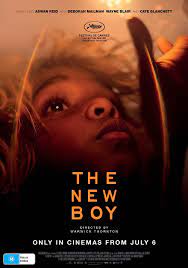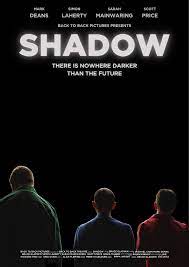Displaying items by tag: Peter Malone's film Reviews
New Boy, The

THE NEW BOY
Australia, 2023, 116 minutes, Colour.
Cate Blanchet, Aswan Reid, Deborah Mailman, Wayne Blair, Shane Brady, Tyrique Brady.
Directed by Warwick Thornton.
An intriguing film, colonial attitudes, First Nations people, religion and faith. As a realistic representation of Australian history, not so much. Writer-director, Warwick Thornton (Samson and Delilah, Sweet Country) references his own boyhood experience with the monks at Western Australia’s, New Norcia, the architecture of the convent, the agricultural background, winter, olives… As a probing of the impact of missionaries (especially Catholics and nuns), quite an allegory to be explored – the lives of the indigenous people, especially focusing on the new boy of the title (about 11 years old, never named though the orphan boys initially called him Darkie, a wonderful screen presence by Aswan Reid). No explanation of his origins except the opening where he throttles a policeman, is taken into custody, in a bag, dumped at the convent at night. There are two indigenous characters at the convent, Sister Mum, the benign cook, and George, the taciturn handyman, (played by veterans Deborah Mailman and Wayne Blair).
Ordinary audiences may be bewildered and/or put off by the focus on Jesus, prayer, piety and devotion and, above all, the large new crucifix, the excited arrival, elevated in the chapel and the nails hammered in. (The final long-held image of the film is the crucifix). But, for religious audiences, there is a fascination with how the new boy responds to the crucifix, identifying with Jesus, embracing, literally, the figure of Jesus, taking him down from the cross, tender towards him, removing the nails, the boy identifying with Jesus, even to wounded hands, becoming what we might call a Christ figure. Which highlights the challenge of the church and the Mission to the indigenous people and their embrace of Jesus in Christian practice and the meeting of Dreaming and lore and the Gospels.
This is embodied in Sister Eileen (and a worldwide audience wanting to see a Cate Blanchett film). Promotion refers to her as a “”renegade nun”. Not really, quite misleading. She is definitely eccentric, deeply committed in her way, sometimes mentally disturbed, sometimes drinking, devoutly prayerful, the crucifix. She exercises power over the small group of under-12 orphan boys, (with a World War II setting) but combines orders and discipline with kindness. And the boys respond. As does the new boy though he is often bewildered (sleeping under the bed, mystified by spoons for porridge, not speaking except a few of his own words, but, ultimately, his word is a repeated Amen. And, mysteriously, he has the power to create fire in his hand, a kind of numinous link. There is no priest, Sister Eileen taking over from Dom Peter, interpreting rules, performing baptisms, stole and chasuble, even the new boy, cleaning and dressing up, but the loss of his power of fire. She has set up her own church but relies on her piety. Cate Blanchet as usual, a tour de force presence. So, a 21st-century perspective by a top filmmaker, provocative on colonial issues, on missionary issues, the consequences, but relying on traditions and art of Catholicism to evoke deeper social and spiritual responses.
1. The title, the introduction to the boy, his age, attacking the policeman, throttling him? Taken into custody, in the bag, dumped at the convent door, aboriginal boy?
2. The setting, Western Australia, the director’s own story at New Norcia, the background of the monks at New Norcia, schools, the sisters? The convent, the accommodation, the rooms, dining room, kitchen? The farm, olives, the wheat, the machinery? The field fires and putting them out? The authentic atmosphere? The Nick Cave-Warren Ellis score?
3. The World War II setting, the West Australian countryside, the train, the passengers, the soldiers, talk about the war? The King’s final speech and peace?
4. The credibility of the plot? The nuns, the death of Dom Peter, the isolation, the covering the death, running the school themselves? Possibilities of discovery? Sister Eileen writing the letters in Dom Peter’s name? To the state protector? Feigning the argument with Dom Peter to deliver the crucifix? The two sisters, isolated? The running of the school, personal lives, relationship with the boys? The acceptance of the new boy, his place in the school, then making exceptions for him?
5. The story of the boy, age, his own language, rarely speaking, the mystery of the convent, the bed, sleeping under the bed? The mysterious fire in his hand? Indication of powers, traditional lore? The food, awkwardness with the spoon? Relationship with the other boys? Matthew punching him, the boys cheering, the new boy knocking down Matthew? The bond between them? The interactions with Sister Eileen? The happy interactions with Sister Mum? Interactions with George, George’s suspicions? In the chapel, the prayer, the arrival of the crucifix, the boy and his reaction to the crucifix, the nails, climbing the crucifix, hanging on to Jesus, the relationship with Jesus, taking out the nails, taking Jesus away, tending to him with the jam, injuring his own hands? Sister Eileen’s reaction? Jobs, the games, putting out the fires, the olives, the wheat? His riding on the wagon? Gradually adapting? Saying amen? Sister Eileen baptising him? Washing him, combing his hair, clothes? The game, the roller up the hill, George urging him to go? His future? And the loss of the fire in his hand?
6. The portrait of Sister Eileen, her piety, prayer, the habit, the chapel, baptising Johnny, wearing the stole, baptism the priestly thing, farewelling Johnny? Johnny and his walking away with a suitcase? Her drinking? Her relationship with Sister Mum? Power, discipline, Michael is the head boy, the caning? Her reaction? The work, out in the fields? Her response to the new boy, caring for him, empathy, making him special, her reaction to him with the crucifix, putting the crucifix back, George hammering in the nails, her decision to baptise the boy? Wearing stole and chasuble? The change in the boy, the game, his leaving? Her future? The deception about Dom Peter, pretending that he was present, his death, signing the documents, for the police, the letters to the protector, the argument about the delivery of the crucifix? Her future?
7. Sister Mum, kindly, cooking, her photo with the children, her vocation, with the boys, happy, prayer?
8. George, aboriginal background, working for the sisters, handyman, the olive crop, the wheat, putting up the crucifix? Finally urging the new boy to run?
9. The boys, their age, orphans, entrusted to the nuns, the background of the war, Johnny, 13, leaving, to work on the farm, the baptism, his suitcase and walking away? Michael in charge, bossy, the caning, the injuries during the fire, in the wheelchair? Matthew, big, the fight with the new boy, the reconciliation? The role of the other boys, in the chapel, the clothes, the work, the meals? Their reaction to the new boy?
10. The background of the police, attitudes towards aboriginals, the rest of the boy, delivery at night? The threat of the police?
11. The film as an allegory of colonial attitudes, missionary attitudes, the indigenous people? The effect?
12. The spirituality themes, the focus on Jesus, the crucifix, the nuns prayer, the boys prayer, the new boy and his response to Jesus? Faith and spiritual themes?
Shadow/ Australia

SHADOW
Australia, 2021, 56 minutes, Colour.
Mark Deans, Simon Laherty, Sarah Mainwaring, Scott Price, Michael Chan, Bruce Gladwin.
Directed by Bruce Gladwin..
This is a brief feature film, made by the Back-to-Back Theatre group, based on a play that the group had developed over some years, Shadow, Whose Prey the Hunter Becomes. It was filmed in Geelong, some scenes of Corio Bay, but most of the action in The Playhouse.
The principal reason for seeing this film is that it focuses on men and women with disabilities, although there is a lot of discussion about the nature of disability, the use of the word, especially concerning brain functioning,
And the film was written and performed by the cast with disabilities, and filmed with a crew with disabilities, 95% of them, but with professional mentors.
The dialogue of the film was worked on by its four central characters. And they perform, dramatise their situations. While this film is important for audiences to appreciate men and women with disabilities, to watch, to listen, not to judge, but to appreciate and understand, the development of the plot is not what audiences might expect.
The cast and audience gather in the foyer of The Playhouse, the cinema audience entering with them, everyone finding a place to observe the action. Our attention has been alerted in the foyer by a rather genial character, Mark, with Down Syndrome. And we glance around to see the other men and women present, the way they look, the way they observe, most of them not contributing verbally to the action. There are some of the carers present amongst the audience and a journalist who arrives late, takes notes throughout.
The situation is that this is a town meeting, with Simon, middle-aged, articulate in his way, unable to explain his situation as regards ideas, thinking, expression, but continually upstaged by Scott, who explains that he has mental disability but is autistic, not hesitating to intervene, drawing on information expertise, Moody, defying Simon, sometimes walking out, but returning and intervening and intruding. But, the character who demands most attention is Sarah, 36, articulate but expressing herself slowly and deliberately. It is she who raises objections about the language of disability. She is assertive on her own condition but also what she can achieve. Along with Scott, she has the most lines. She also suggests using the language of “neurodiversity”.
But the situation is not what we expect. The group has the intention of bettering the world, saving the world. Ideals are propounded, Simon trying to manage the meeting, Scott raising all kinds of complexities, Sarah making her stances, Mark in the audience, smiling, focusing on his food. The upshot of the discussion is the question about whether the world can be saved, whether this group is able to do any saving, conscious as they are of their strengths and disabilities, needing to save themselves before they can save the world.
This is a brief film that would contribute to “normal” (the word used by the actors for reference) audiences understanding the nature of mental disabilities, making them pause, non-judgemental, adapting expectations, finding ways to collaborate and to contribute to understanding and appreciation. As has happened with Back-to-Back Theatre and this film.